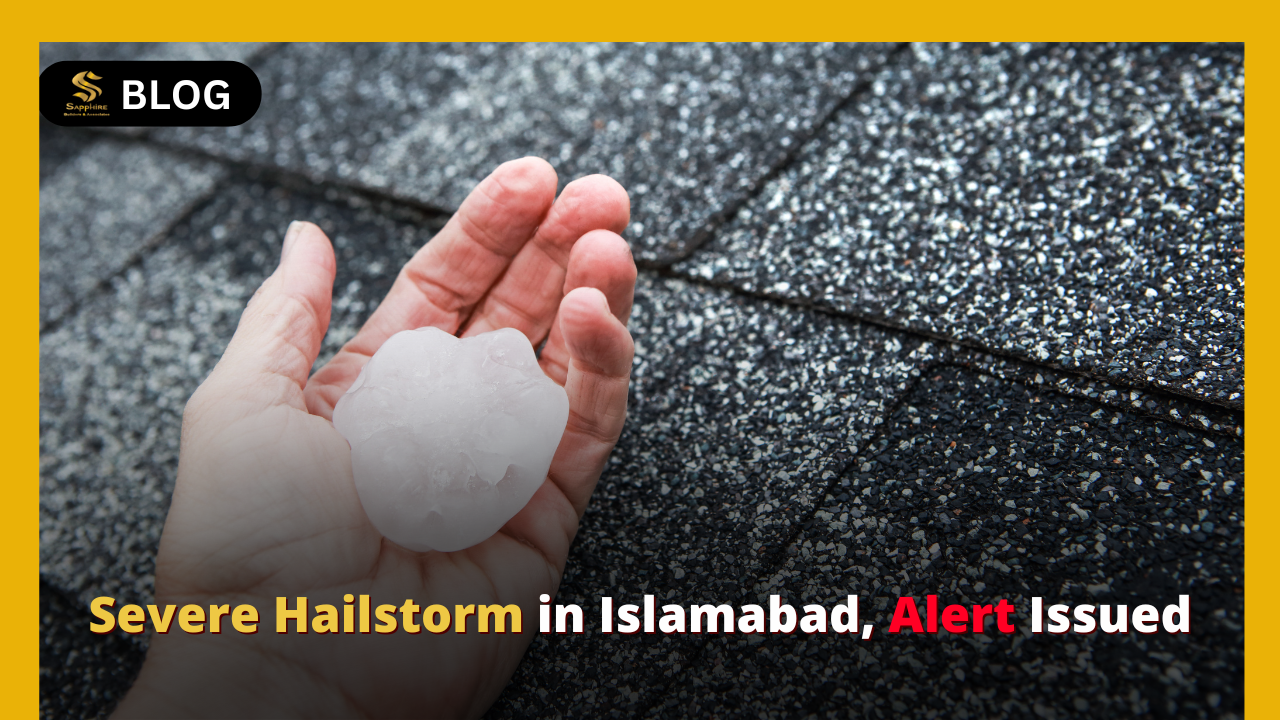
Share This Story, Choose Your Platform!
Heavy Hailstorm in Islamabad – Emergency Measures Advised
On April 16, 2025, Islamabad was hit by a sudden and intense hailstorm that turned the city’s serene spring afternoon into a scene of chaos. Lasting approximately 35 minutes, the storm brought with it unusually large hailstones, powerful winds, and heavy rainfall, leaving behind a trail of damage and raising urgent questions about the city’s climate preparedness.
Destruction caused by the Heavy Hailstorm in Islamabad
From damaged vehicles to widespread power outages, the impact of the hailstorm was both visible and severe. Windscreens of hundreds of cars were smashed, solar panels were shattered, and rooftops in several areas bore the brunt of the hail. In localities like Tarnol, large hailstones and uprooted trees brought traffic to a standstill. The Capital Development Authority (CDA) faced major challenges as uprooted trees and flooding blocked multiple roads and underpasses.
Power infrastructure, too, wasn’t spared. Several sectors of Islamabad experienced power outages, with teams scrambling late into the night to restore electricity. In neighboring regions of Khyber Pakhtunkhwa, flash floods disrupted daily life and made roads impassable, highlighting the storm’s broader geographical impact.
How Do Hailstorms Form?
Hailstorms begin in strong thunderstorms when powerful updrafts carry water droplets into freezing cloud tops. Those droplets freeze into ice pellets and cycle up and down, accumulating layers of ice. Once they grow too heavy for the updrafts to support, they fall as hailstones, with their size reflecting the storm’s intensity.

You May Also Read
Experience the Best Quality Construction in Islamabad: A Deep Dive into Opal Mall & Luxury Suites
A Glimpse Into the Climate Crisis
Experts and environmentalists were quick to point out that this was no ordinary weather anomaly. This hailstorm is being seen as part of a disturbing pattern of extreme and unpredictable weather events driven by climate change. The increasing frequency and intensity of such events are not just environmental warnings, they’re a signal for policymakers and citizens alike to take immediate, proactive measures.
Former officials and climate advocates emphasized how human-induced emissions and global warming are amplifying weather volatility. The fact that a hailstorm of this magnitude struck in April, a month not traditionally known for such extreme weather in Islamabad, is a stark indicator of shifting climate dynamics.
Urban Vulnerabilities Exposed
While nature was the root cause of the disaster, the storm also revealed serious gaps in urban planning. Islamabad’s drainage systems struggled under the pressure, with water pooling in low-lying areas and causing mobility issues. The lack of resilient infrastructure, from power lines to storm water management systems, made it clear that the city is not adequately equipped to handle sudden weather disruptions.
Precautionary Measures: How to Prepare for Future Hailstorms
In the wake of Islamabad’s recent hailstorm, it’s vital that residents and property owners take action to minimize damage in the future. While weather events can’t be controlled, smart planning and simple measures can significantly reduce their impact on life and property.
How to Protect Vehicles from Hail Damage
- Park in Covered Areas: Always opt for underground parking or covered garages, especially during weather alerts. If unavailable, use temporary carports or hail protection canopies.
- Use Hail Covers: Invest in padded hail car covers or thick blankets to shield your vehicle’s surface and windshield during sudden storms.
- Avoid Parking Under Trees: While it may offer shade, falling branches during high winds can cause severe damage.
How to Protect Solar Panels
- Install Hail-Resistant Panels: Use panels that are certified for high impact resistance (IEC 61215 standard). These are tested to withstand hailstones up to 25mm at high speed.
- Protective Mesh or Covers: Install transparent hail protection mesh or shields that absorb impact without affecting sunlight absorption.
- Adjustable Angles: If possible, use solar panels with adjustable tilt mechanisms that can be shifted during storm forecasts to reduce direct impact.
How to Protect Window Glass and Building Exteriors
- Install Shatterproof or Tempered Glass: These types of glass are more resistant to breakage and don’t shatter dangerously.
- Use Storm Shutters: On windows and glass doors, storm shutters or roll-down metal covers can protect from flying debris and hail.
- Window Films: Apply impact-resistant safety films on glass windows to help hold shattered pieces together.
- Roof Inspection & Strengthening: Regularly inspect rooftops for weak points, loose tiles, or cracks. Use hail-rated roofing materials for better protection.
General Storm Safety Tips
- Monitor Weather Alerts: Sign up for real-time weather alerts from the Pakistan Meteorological Department or install weather apps with push notifications.
- Emergency Kits: Keep basic supplies like flashlights, batteries, power banks, water, and first aid kits ready.
- Tree Maintenance: Trim trees around your property regularly to prevent branches from breaking onto roofs or roads.
- Insurance Coverage: Ensure your property and vehicle insurance covers natural disasters like hailstorms.
Conclusion
As unpredictable weather patterns become more frequent, preparedness is no longer optional, it’s essential. Islamabad’s April 2025 hailstorm is a clear message that urban planning, personal responsibility, and timely precautions must go hand-in-hand.
By taking these simple but effective measures, you can help protect your home, vehicles, and loved ones from future climate surprises.



